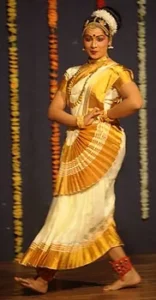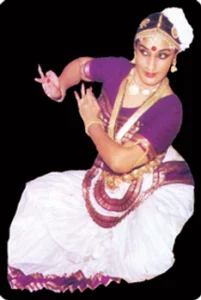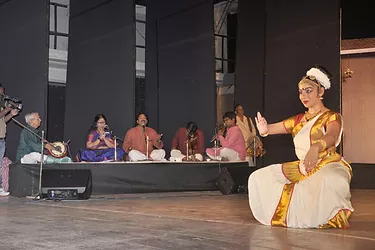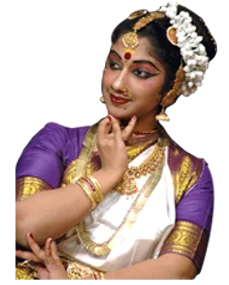Mohiniattam
Originating from Kerala in South India, this is a dance style exclusively performed by women. ‘Mohini’ means a seducing woman and ‘attam’ means dance. So this dance is enchantingly feminine with wave-like body movements. The theme of the dance is generally ‘sringara’ or love. Delicate themes of love are performed with suggestive gestures, rhythmic footwork and lyrical music.
Mohiniattam
Originating from Kerala in South India, this is a dance style exclusively performed by women. ‘Mohini’ means a seducing woman and ‘attam’ means dance. So this dance is enchantingly feminine with wave-like body movements. The theme of the dance is generally ‘sringara’ or love. Delicate themes of love are performed with suggestive gestures, rhythmic footwork and lyrical music.
There are many stories, the most popular one being the myth of the churning of the ocean. Once upon a time the gods and the demons churned the milky ocean to get the nectar of immortality.
When the deity holding the jar of nectar appeared, the demons managed to snatch it first, creating fear among the gods. Lord Vishnu appeared in the form of Mohini, an enchanting woman. Mohini entranced and distracted the demons so that the Gods were able to take the nectar away.
Similarly Mohini helped Lord Shiva in destroying a demon named Bhasmasura. Mohini entranced him by her beauty into a dance-step which caused his destruction.
Accordingly, the dance of Mohiniattam symbolizes a dance of protection and enchantment.
There are references to Mohiniattam as early as the 18th century. The great poet scholar king Swathi Thirunal (19th century) encouraged musicians to compose songs for this art form. The dance was largely ignored after his reign. The great Malayalam poet Vallathol revived Mohiniattam with the founding (1930) of Kerala Kalamandalam, an institute of Kerala dances. Since then, Mohiniattam has gained prominence among classical dance styles of India.
There are many stories, the most popular one being the myth of the churning of the ocean. Once upon a time the gods and the demons churned the milky ocean to get the nectar of immortality.
When the deity holding the jar of nectar appeared, the demons managed to snatch it first, creating fear among the gods. Lord Vishnu appeared in the form of Mohini, an enchanting woman. Mohini entranced and distracted the demons so that the Gods were able to take the nectar away.
Similarly Mohini helped Lord Shiva in destroying a demon named Bhasmasura. Mohini entranced him by her beauty into a dance-step which caused his destruction.
Accordingly, the dance of Mohiniattam symbolizes a dance of protection and enchantment.
There are references to Mohiniattam as early as the 18th century. The great poet scholar king Swathi Thirunal (19th century) encouraged musicians to compose songs for this art form. The dance was largely ignored after his reign. The great Malayalam poet Vallathol revived Mohiniattam with the founding (1930) of Kerala Kalamandalam, an institute of Kerala dances. Since then, Mohiniattam has gained prominence among classical dance styles of India.
Accompaniments
The accompaniments for Mohiniattam are: Vocal support (Carnatic classical), Cymbals, Violin and Indian musical instruments such as Mridangam (a percussion instrument), Maddalam (another percussion instrument) and Edakka (an hour-glass shaped percussion instrument played with a stick).
Costume and Jewellery
The costume is a pleated saree, mostly white or cream-white. The jewellery includes special head-ornaments, ear-rings, necklace, bangles, rings, waist-ornaments and anklets. A bunch of jasmine flowers adorns the hair tied into a bun.
20 Days Short Term Course
in Mohiniattam
Mohiniattam Nritya Kalakshetra
New Delhi, India
Location:
New Delhi, India
Outline:
A short course of 20 week-days spread over 4 weeks (2 hours each day). Saturday & Sunday holidays. Comprehensive text books (Mohiniattam & Mohiniattam Adavus) provided.
Dates:
No specific dates. Just let us know one month in advance.
Books for sale
(All by Geeta Radhakrishna)
- Mohiniattam – The Dance of the Enchantress
- Mohiniattam – Adavus and Mudras
- Jayadeva’s Gita Govinda (Poem)
- Prakruti Nrityam – The Dance of Nature (Poem)
- Meditation on Ahimsa
- Devi Mahatmyam – Mystic Power of the Radiant Goddess







